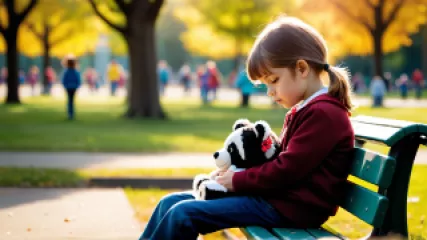The Definitive Guide to Understanding Childhood Trauma
Understanding childhood trauma is crucial for addressing and treating it effectively. This comprehensive guide delves deep into the complexities of childhood trauma, shedding light on its causes, effects, and the paths to recovery. By understanding the intricacies of this issue, we can better support those affected and promote a healthier society.
Understanding Childhood Trauma
Childhood trauma is a pervasive issue that can have long-lasting impacts on an individual's emotional wellbeing and mental wellness. It encompasses a range of experiences that cause significant distress or dysfunction. These experiences can be acute, such as a single event, or chronic, involving ongoing exposure to harmful conditions.
Defining Childhood Trauma
Childhood trauma refers to adverse experiences during childhood that profoundly affect a child's emotional, psychological, or physical health. These experiences can include:
- Physical, emotional, or sexual abuse
- Neglect or abandonment
- Witnessing domestic violence
- Severe illness or injury
- Natural disasters
- Loss of a loved one
- Bullying or community violence
The Impact of Childhood Trauma on Development
The effects of childhood trauma can be profound and far-reaching. Trauma can disrupt normal development in various ways, including:
- Emotional Regulation: Children exposed to trauma often struggle with regulating their emotions. They may exhibit intense emotional reactions or have difficulty managing stress.
- Behavioral Issues: Traumatized children may display problematic behaviors such as aggression, defiance, or withdrawal.
- Cognitive Development: Trauma can impair cognitive functions, leading to difficulties with attention, memory, and academic performance.
- Social Relationships: Traumatized children may have trouble forming healthy relationships, often due to trust issues or social anxiety.
The Neurobiology of Trauma
Childhood trauma not only affects emotional and psychological well-being but also has a profound impact on brain development. Understanding the neurobiological effects of trauma can help in developing effective intervention strategies.
The Brain's Response to Trauma
When a child experiences trauma, their brain undergoes significant changes. The brain's response to trauma involves several key areas:
- Amygdala: Responsible for processing emotions, especially fear, the amygdala becomes hyperactive in traumatized individuals, leading to heightened anxiety and vigilance.
- Hippocampus: Essential for memory formation, the hippocampus can shrink in size due to chronic stress, affecting a child's ability to remember and learn.
- Prefrontal Cortex: Regulates decision-making and impulse control. Trauma can impair its development, leading to difficulties in these areas.
Stress Hormones and Their Effects
Trauma triggers the release of stress hormones such as cortisol and adrenaline. While these hormones are vital for a fight-or-flight response, chronic exposure can have detrimental effects, including:
- Increased risk of mental health disorders such as anxiety and depression
- Weakened immune system
- Disrupted sleep patterns
- Higher susceptibility to chronic illnesses
Recognizing Signs of Childhood Trauma
Identifying the signs of childhood trauma early on is crucial for providing timely and effective support. Symptoms can vary widely depending on the child's age, personality, and the nature of the trauma.
Behavioral Indicators
Traumatized children may exhibit a range of behavioral signs, including:
- Excessive anger or irritability
- Withdrawal from friends and family
- Regressive behaviors such as bedwetting or thumb-sucking
- Difficulty concentrating or hyperactivity
- Frequent nightmares or sleep disturbances
- Risky behaviors or substance abuse in older children
Emotional and Psychological Signs
Beyond behavior, trauma can manifest through emotional and psychological symptoms, such as:
- Persistent sadness or depression
- Anxiety or panic attacks
- Feelings of guilt or shame
- Fearfulness or phobias
- Low self-esteem or feelings of worthlessness
Pathways to Healing and Recovery
Recovery from childhood trauma is a complex journey, requiring a multifaceted approach. Effective trauma recovery support involves addressing both the emotional and physiological impacts of trauma.
Therapeutic Interventions
Several therapeutic approaches have proven effective in treating childhood trauma:
- Cognitive Behavioral Therapy (CBT): Helps children reframe negative thoughts and develop coping strategies.
- Eye Movement Desensitization and Reprocessing (EMDR): A therapy that helps process and integrate traumatic memories.
- Play Therapy: Allows younger children to express their feelings and experiences through play.
- Family Therapy: Involves the family in the healing process, improving communication and support.
Building Resilience
Resilience is the ability to bounce back from adversity. Building resilience in children can significantly aid in their recovery from trauma. Key strategies include:
- Providing a stable and supportive environment
- Encouraging positive relationships with peers and adults
- Promoting healthy coping mechanisms through activities like sports, arts, and mindfulness practices
- Teaching problem-solving and stress management skills
The Role of Caregivers and Educators
Caregivers and educators play a pivotal role in supporting children who have experienced trauma. Their understanding and actions can significantly influence a child's recovery journey.
Creating a Safe and Supportive Environment
Ensuring a child feels safe and supported is fundamental. This involves:
- Maintaining consistent routines to provide a sense of stability
- Listening and validating the child's feelings without judgment
- Being patient and understanding of behavioral challenges
- Encouraging open communication about their experiences and feelings
Educating and Empowering
Caregivers and educators should also focus on educating themselves and the child about trauma and its effects. Empowering the child with knowledge can help them understand their own experiences and foster a sense of control.
Dr. Bruce Perry once stated, "The more healthy relationships a child has, the less likely he will be to develop a wide range of behavioral problems."
Community and Societal Support
Addressing childhood trauma is not solely the responsibility of caregivers and educators. Communities and society at large must also contribute to creating a supportive environment for affected children.
Community Programs and Initiatives
Various community programs can provide essential support for children and families dealing with trauma. These programs often focus on:
- Providing access to mental health services
- Offering educational workshops and resources for parents and caregivers
- Creating safe spaces for children to engage in recreational activities
- Building networks of support among families facing similar challenges
Policy and Advocacy
Advocating for policies that protect children and support trauma recovery is crucial. This includes:
- Implementing trauma-informed practices in schools and healthcare settings
- Ensuring access to affordable mental health care
- Promoting awareness campaigns to educate the public about childhood trauma
- Supporting research on effective interventions and prevention strategies
Personal Stories of Overcoming Childhood Trauma
Hearing personal stories of overcoming childhood trauma can be incredibly inspiring and provide hope to those still on their journey. Below are a few accounts of triumph over adversity.
Kendrick Stewart's Journey
Kendrick Stewart grew up in an environment marked by domestic violence and neglect. Despite these challenges, he found solace in his schoolwork and sports. With the support of a dedicated teacher and a therapist, Kendrick managed to excel academically and eventually earned a scholarship to college. Today, he advocates for trauma-informed educational practices and mentors young people facing similar struggles.
Gabrielle Rivera's Path to Healing
Gabrielle Rivera experienced severe bullying in her childhood, which led to anxiety and depression. Her turning point came when she joined a local theater group, where she found a supportive community and an outlet for her emotions. Through therapy and the arts, Gabrielle learned to manage her trauma and now works as a drama therapist, helping others heal through creative expression.
Conclusion: Moving Forward with Hope and Resilience
Childhood trauma is a complex issue that requires a multi-faceted approach to address. By understanding the nature of childhood trauma, recognizing its signs, and implementing effective therapeutic and supportive measures, we can significantly improve the lives of those affected.
It is crucial for caregivers, educators, and communities to work together to create environments where children feel safe, supported, and understood. With the right resources and support, children can overcome their traumatic experiences and lead fulfilling lives.
As we move forward, let us commit to fostering resilience and promoting mental wellness for all children, ensuring that they have the opportunity to thrive despite their past adversities.






